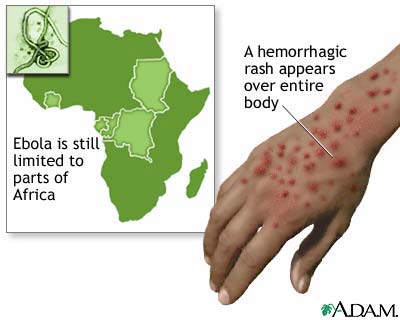
Ebola disease has attracted a lot of media attention in the recent past and rightly so. With the ongoing epidemic in Guinea, here are some things you should know about Ebola Haemorrhagic Disease (aka Ebola Haemorrhagic fever, Ebola).
Ebola is a viral haemorrhagic disease caused by the Ebola virus. It was first discovered in 1976 following outbreaks in Sudan and Zaire (now Democratic Republic of Congo). There are 5 strains of the virus: Zaire, Sudan, Reston, Cote D’Ivoire and Tai forest ebola viruses. Ebola is a deadly disease as evidenced by its high case fatality rates.
Ebola is transmitted via direct contact with any bodily fluid and tissue of an infected person. Infection could be through direct or indirect contact with blood, saliva, corpses of persons infected with the disease to mention a few. There are also some animal reservoirs of the virus. Examples include gorillas, chimpanzees, rodents, fruit bats. So, improper preparation and inadequate cooking of some bush meats pose an additional risk factor to contracting the disease. Overall, human to human contact is the most common route of infection.
This year, the first outbreak of Ebola virus was reported in Guinea, as of April 5th 2014 a total of 151 suspected and confirmed cases with 95 deaths have been reported the Ministry of Health according to the Centre for Disease Control. In Liberia, 18 suspected cases been reported by the Ministry of Health and Social Welfare, Liberia and the World Health Organisation with 7 deaths. Mali and Sierra Leone have reported suspected cases which are under investigation. Ebola has previously been reported in other parts of the world previously including Italy, the Philippines and the United States several years ago.
So, what do you look out for? Ebola is a haemorrhagic fever and is therefore similar in symptomatology to many other febrile illnesses common in Sub- Saharan Africa. However, the incubation period (average time between exposure to the virus and when symptoms begin to develop) ranges from 2-21 days. This means that it is possible to contract the virus and transmit it while still being asymptomatic for it. It is important to note that Ebola fever can affect virtually every system in the body though common symptoms include: Fever with flu-like malaise, generalised weakness, sore throat, joint pains, abdominal pains, vomiting, diarrhoea etc. Skin presentation includes evidence of haemorrhaging (hence the term ‘Haemorrhagic’) into the skin such as petechiae, ecchymosis and hematoma. These are often signs of poor prognosis.
What to do: Once a case is suspected, it must be reported to the relevant health authorities immediately particularly during an epidemic. This is to ensure quarantine and confirm the diagnosis. A laboratory diagnosis must be done to confirm the diagnosis because there are so many other viral diseases that are similar to Ebola such as Marburg’s disease, Typhoid fever, Malaria and so on.
Treatment is largely supportive since there is no actual drug therapy for the disease. Fluid and electrolyte management are the mainstay. Antibiotics are not effective against the disease because it is not a bacterial infection. However, antibiotics may be used to prevent bacterial superimposition on the disease.
Prevention is very crucial to breaking the disease transmission and overcoming the epidemic. Avoiding direct and indirect contact with bodily fluids and tissue of infected persons is the way to go. The practice of barrier nursing for patients in hospitals is effective, so also is frequent hand washing. The use of gloves and appropriate personal protective equipment must be used in taking care of ill patients. Proper handling of corpses which may involve a modification of burial practices is also a preventative step. There are currently no vaccines for the prevention of Ebola fever though research is ongoing. The reporting of suspected cases to relevant health authorities cannot be over-emphasized.
Do not despair! Ebola Virus disease can be contained if appropriate steps are taken early, besides it is usually easy to recognise people with the illness as they are often quite sick! Proper public health practice is the best way to manage this epidemic for instance, Lagos State Government has a Surveillance Program which monitors all hospitals within the state. This is to ensure that all suspected cases can easily be referred to the closest General hospital where adequate care for the disease is available, so do a number of other States within the country.
Integra Health Nigeria

